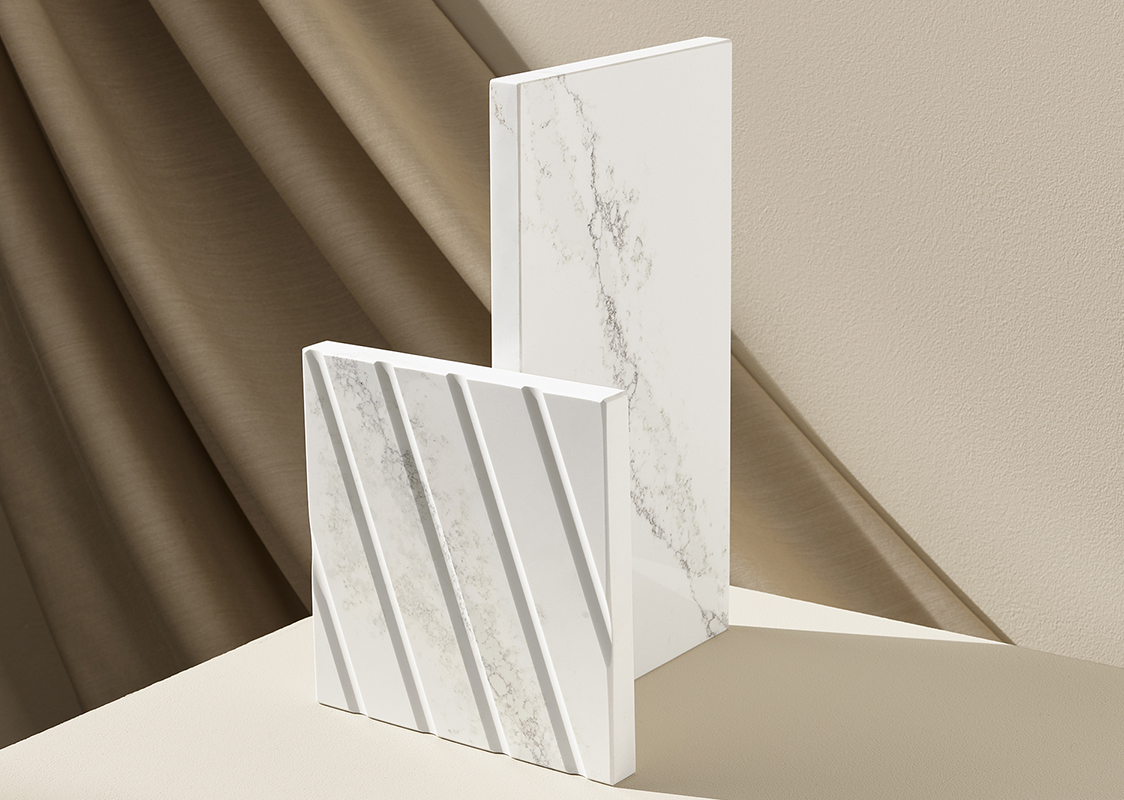While some of the ceramic manufacturers have always maintained that sintered stone is just another name for porcelain, the European Commission (EC) and European Organisation for Technical Assessment (EOTA) have now adopted a new European Assessment Document (EAD) that defines Sintered Stone in a category of its own.
The definition is as follows: ‘An industrial product consisting of a wet mix of minerals, without the use of resin or cement. The material is cold-formed by vacuum vibro-compression and then consolidated, after drying, by sintering at temperatures between 1,100 and 1,200°C. The production process is reversible. The material can be used in architecture and design for various interior and / or exterior applications and can be installed by means of adhesives, structural bonding or mechanical fixings.'
And Lapitec, made by Italian machinery company Breton, is the first sintered stone to carry a CE-mark.
Breton was the machinery company that developed the equipment for making engineered quartz. Having done so, it sold that equipment to other companies to make the slabs. With Lapitec, it decided to keep the production equipment for itself and make the slabs.
It originally worked in conjunction with Spanish quartz company Cosentino, which makes Silestone, on the development of sintered stone, but Cosentino decided to manufacture its own version, which it has successfully marketed under the name of Dekton, even though making worktops from Dekton has given fabricators some headaches. Dekton has the design printed on it whereas Lapitec has achieved full thickness patterns.
Lapitec always wanted the pattern to be full thickness. When it introduced its marble look tops in 2019 the design was not just printed on, as it is with porcelains, but was part of the fabric of the material.
The first Lapitec slab was produced in 2012. The company says it was the result of 20 years of research and development. It says sintered stone is an Italian invention and is now recognised in more than 70 countries by project, design and construction professionals.
Lapitec sintered stone offers a 100% mineral core that does not use petroleum derivatives (like the resins commonly used in engineered quartz). The first marble effects also introduced a formula free of crystalline silica – and crystalline silica has caused increasing concern among worktop fabricators because of the danger of silicosis from the dust. Lapitec has replaced crystalline silica with a trade-marked product it calls Biorite.
The technology behind Lapitec is protected by 25 international patents. The process involves a lot of heat and pressure, just as the creation of natural stone does, although in the case of natural stone it comes from processes in the Earth's crust. With Lapitec the minerals involved are heated to 1,500°C and compacted under vacuum. They are then heated to 1,200°C to produce large slabs.
The EC and EOTA has decided that sintered stone has properties that are distinct from ceramic, natural and composite stones.
Lapitec says no other material on the market possesses similar characteristics and consequently sintered stone was originally subject to different building regulations in various EU nations. With the adoption of the new European Assessment Document (EAD) for Sintered Stone (EAD 090142-00-0404) that has now changed in Europe.
EAD 090142-00-0404 contains a list of essential characteristics of sintered stone. The EAD sheds light on the differences between Sintered Stone and Ceramics in order to avoid overlaps and any misuse of terms. Surfaces that meet the requirements of the new EAD can be CE marked (using existing criteria) as sintered stone.
Following tests and the completion of an appropriate Declaration of Performance (DoP), Lapitec is currently the only sintered material carrying a CE mark.
Lapitec Sales Executive Francesco Giannini says: "All too often other materials are wrongly promoted as sintered stone and this new step will shed light on a long-standing problem that undermines the market niche that we have been presiding over for more than a decade."
Today, Lapitec is sold in the UK by stone wholesaler The Marble & Granite Centre in Rickmansworth, Hertfordshire. It is available in large slabs, in thicknesses of 12, 20 and 30mm in 18 designs with six alternative surface finishes. All have full-thickness veining.
Non-porous on the surface, it is resistant to temperature changes, frost and high temperatures, UV rays, scratches and chemicals. It can be used in direct contact with water and its high performance, sustainability and availability in XXL sizes make it ideal for use in ventilated facades (rainscreens) and roofing, indoor and outdoor horizontal and vertical surfaces, for swimming pool cladding and in yachts, as well as for kitchen and table tops.

